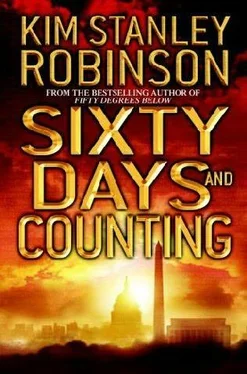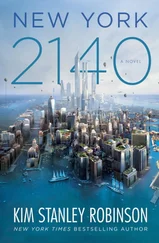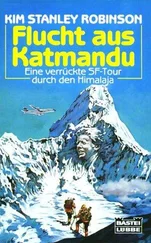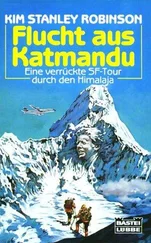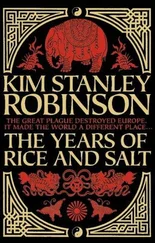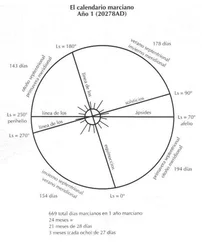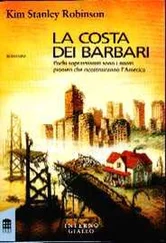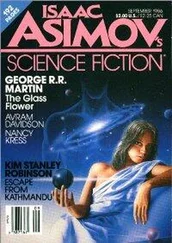They array themselves in a line facing the Dalai Lama, and the American woman who first welcomed them returns to the lectern to explain to the audience that these are representatives of all the Buddhist communities in Asia who regard the Dalai Lama as their spiritual leader. More applause.
Each representative approaches the Dalai Lama in turn, holding a white scarf. With a bow the Dalai Lama takes the scarves, bows again, often touching foreheads with the person who has approached, then puts the scarves around their necks. After a verbal exchange not broadcast to the crowd, the representatives move to one side.
Some are clearly almost overwhelmed by this interaction with the Dalai Lama. They crab toward him, or walk bent in a bow. But the Dalai Lama greets all alike with a big grin and a friendly greeting, and when they leave him they have straightened up and are more relaxed.
The last dignitary to approach is Drepung, in flowing white robes. It takes checking on the big screen to be sure of this. Yes, their Drepung. Joe is jerking up and down in Charlie’s arms, pointing. Nick too is pointing.
The almost stereopticon effect of the two images, one little and three-dimensional, one huge and two-dimensional, creates a kind of hyperreality, a five-dimensional vertigo. On the screen, one can see that under his white ceremonial robes Drepung is still wearing his running shoes, now more enormous than ever. He bounces toward the Dalai Lama with a huge grin on his face, the Dalai Lama matching it watt for watt; they seem to know each other. The Dalai Lama bows as Drepung approaches, Drepung bows, they keep eye contact all the while. They meet and touch foreheads, Drepung bowing lower to make this contact, even though the Dalai Lama is not a small man. The crowd cheers. Many Asians around them are weeping. Drepung hands the Dalai Lama the white scarf he is carrying, and the Dalai Lama touches it to his forehead and puts it around Drepung’s neck, Drepung bowing low to receive it. When that’s done they speak for a bit in Tibetan, laughing at something. The Dalai Lama asks a question, Drepung cocks his head to the side, nods, makes some jest; laughing, the Dalai Lama turns and takes a white scarf from one of his aides standing behind, then gives it to Drepung. Drepung touches it to his forehead, then extends it over the Dalai Lama’s bowed head and places it around his neck. As the Dalai Lama straightens, Drepung flicks one end of the scarf and it lands over the Dalai Lama’s shoulder like a flapper’s boa. The Dalai Lama laughs and vamps for a second, to audience laughter, then gestures Drepung off the stage as if shooing away a fly.
The white-scarved group also leaves the stage. The Dalai Lama sits down in the armchair to the left, across from his compatriot. He puts on a radio microphone that works well, as everyone finds out when he says in a deep voice, “Hello.” Amplification in the arena is clearer than one would have thought possible.
The crowd says hello back. The Dalai Lama kicks off his sandals, leaves them on the carpet and tucks his feet up under his legs, in either a meditation pose or just a comfortable position. Bare arms make it seem he could be cold, but no doubt he is used to it and does not notice. It’s hot outside anyway.
He begins to speak, but in Tibetan. Around his amplified words is silence. The airy whoosh of the building’s ventilation system becomes audible: a surreal disjunction, between the absence of crowd noise and the visible presence of thirteen thousand people. All quiet, all listening intently to a man speaking a language they don’t know.
Low sonorous Tibetan, unlike the sound of Chinese, or the other east Asian languages. Yes, he sounds like Rudra Cakrin. Then he pauses, and the man in the other armchair speaks in English. Ah, the translator. Presumably he is summarizing what the Dalai Lama just said. Another good headset microphone. Voices booming out of the giant black scoreboard console hanging over center court.
The translator finishes translating what was apparently an entirely conventional welcome, and the Dalai Lama starts again in Tibetan. This is going to be a long affair. Then all of a sudden the Dalai Lama switches to English. “I hope we can talk about all this in the rest of our time together. How to live in this world. How to achieve peace and balance.”
His English is perfectly clear. He jokes about his inability in it, and from time to time he dives back into Tibetan, apparently to be sure of being accurate about important things. Possibly even here his attempt in English would be more interesting than the translator’s more expert locutions. In any case, back and forth between languages they bounce, both getting some laughs.
The Dalai Lama talks about the situation they find themselves in, “a difficult moment in history” as he calls it, acknowledging this truth with a shrug. Reality is not easy; as a Tibetan this has been evident all his life; and yet all the more reason not to despair, or even to lose one’s peace of mind. One has to focus on what one can do oneself, and then do that, he says. He says, “We are visitors on this planet. We are here for ninety or one hundred years at the very most. During that period, we must try to do something good, something useful, with our lives. Try to be at peace with yourself, and help others share that peace. If you contribute to other people’s happiness, you will find the true goal, the true meaning of life.”
He sounds so much like Rudra Cakrin. Suddenly it’s hard to believe that such an idiosyncratic mind as Rudra Cakrin’s can be gone. Many of the people here presumably do not believe it. The man speaking is agreed to be the fourteenth reincarnation of a particular mind or soul. Although in an interview published that morning in the Post, the Dalai Lama was asked when he had first recalled his previous lives, and he replied, “I have never had that experience,” and then added, “I am an ordinary human being.” He did not even make any particular claim to special knowledge, or expertise in anything metaphysical.
Now he says, “What happens beyond our senses we cannot know. All we can see indicates that everything is transitory.”
This is not the kind of thing a religious leader is expected to say—admissions of ignorance, jokes about translation error. The whole situation feels nonreligious, more like a fireside chat than the Sermon on the Mount. Maybe the Sermon on the Mount would have felt like that too.
“Knowledge is important, but much more important is the use toward which it is put. This depends on the heart and mind of the one who uses it.”
It’s the argument for always-generous. Even if you only manage to love your own DNA, it exists in a diffuse extension through the biosphere. All the eukaryotes share the basic genes; all life is one. If you love yourself, or just want to survive—or maybe those are the same thing—then the love has to diffuse out into everything, just to be accurate.
To love accurately. The Dalai Lama says something about mindful consumption. We eat the world the way we breathe it. Thanks must be given, devotion must be given. One must pay attention, to do what is right for life.
These were all the things a sociobiologist would recommend, if he could talk about what ought to be as well as what is. Buddhism as the Dalai Lama’s science; science as the scientist’s Buddhism. Again, as when Rudra Cakrin gave his lecture at NSF, it all becomes clear.
Time passes in a flow of ideas. A couple of hours, in fact; no concessions to any suppposedly short attention spans. And the crowd is still silent and attentive. The time has gone fast somehow, and now the Dalai Lama is winding things up by answering a few questions submitted by e-mail, read by his translator from a printout.
Читать дальше
Конец ознакомительного отрывка
Купить книгу
